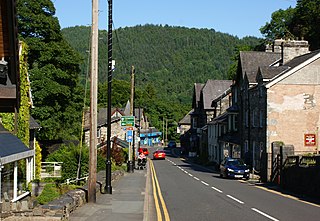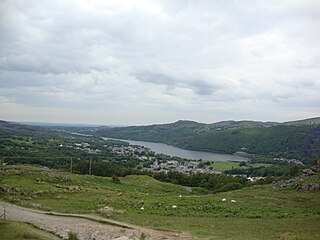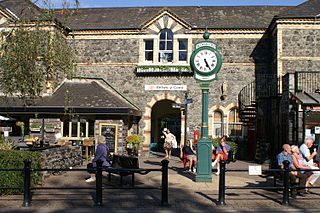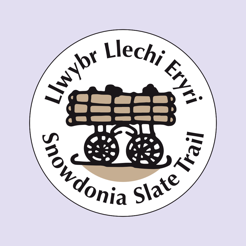
Snowdonia, or Eryri, is a mountainous region and national park in northwestern Wales. It contains all fifteen mountains in Wales over 3000 feet high, including the country's highest, Snowdon, which is 1,085 metres (3,560 ft) tall. These peaks are all part of the Snowdon, Glyderau, and Carneddau ranges in the north of the region. The shorter Moelwynion and Moel Hebog ranges lie immediately to the south.

Caernarfon is a royal town, community and port in Gwynedd, Wales. It has a population of 9,852. It lies along the A487 road, on the eastern shore of the Menai Strait, opposite the island of Anglesey. The city of Bangor is 8.6 miles (13.8 km) to the north-east, while Snowdonia (Eryri) fringes Caernarfon to the east and south-east.

Gwynedd is a county in the north-west of Wales. It borders Anglesey across the Menai Strait to the north, Conwy, Denbighshire, and Powys to the east, Ceredigion over the Dyfi estuary to the south, and the Irish Sea to the west. The city of Bangor is the largest settlement, and the administrative centre is Caernarfon. The preserved county of Gwynedd, which is used for ceremonial purposes, includes the Isle of Anglesey.

Caernarfonshire, sometimes spelled Caernarvonshire or Carnarvonshire, is one of the thirteen historic counties, a vice-county and a former administrative county of Wales.

Betws-y-coed is a village and community in the Conwy valley in Conwy County Borough, Wales, located in the historic county of Caernarfonshire, right on the boundary with Denbighshire, in the Gwydir Forest. It is now a very popular visitor destination in the Snowdonia National Park.

Llanberis is a village, community and electoral ward in Gwynedd, northwest Wales, on the southern bank of the lake Llyn Padarn and at the foot of Snowdon, the highest mountain in Wales. It is a centre for outdoor activities in Snowdonia, including walking, mountaineering, climbing, mountain biking and pony trekking, as well as water sports such as scuba diving. The community includes Nant Peris.

Capel Curig is a village and community in Conwy County Borough, Wales. Historically in Caernarfonshire, it lies in the heart of Snowdonia, on the River Llugwy, and has a population of 226, reducing slightly to 206 at the 2011 census. It lies at the junction of the A5 road from Bangor and Bethesda to Betws-y-Coed with the A4086 road from Caernarfon, Llanberis, Pen-y-Pass and Pen-y-Gwryd. It is surrounded by hills and mountains, including Moel Siabod and Pen Llithrig y Wrach.

Pen-y-Gwryd is a pass at the head of Nantygwryd and Nant Cynnyd rivers close to the foot of Snowdon in Gwynedd, Wales. The area is located at the junction of the A4086 from Capel Curig to Llanberis and Caernarfon and the A498 from Beddgelert and Nant Gwynant about a mile from the head of the Llanberis Pass. It is close to the boundary with Conwy county borough in northern Snowdonia. The famous mountaineering hostelry, Pen-y-Gwryd Hotel, is located in the pass. It is also a mountain rescue post with links to the other rescue posts at Ogwen Cottage and Plas y Brenin.

The Padarn Railway was a narrow-gauge railway in North Wales, built to the unusual gauge of 4 ft. It carried slate seven miles (11 km) from Dinorwic Quarry to Port Dinorwic. The line opened on 3 March 1843, replacing the Dinorwic Railway. It initially used horses, but was converted to steam haulage on 23 November 1848. The railway was formally titled the Dinorwic Quarries Railway or Dinorwic Quarry Railway, but informally "Padarn Railway" was widely used.

The Llanberis Pass in Snowdonia carries the main road (A4086) from the south-east to Llanberis, over Pen-y-Pass, between the mountain ranges of the Glyderau and the Snowdon massif. At the bottom of the pass is the small village of Nant Peris.

Betws-y-coed railway station is on the Conwy Valley Line, which runs between Llandudno and Blaenau Ffestiniog. It is situated 15+1⁄2 miles (24.9 km) south of Llandudno Junction.

Llyn Cowlyd is the deepest lake in northern Wales. It lies in the Snowdonia National Park at the upper end of Cwm Cowlyd on the south-eastern edge of the Carneddau range of mountains, at a height of 1,164 feet (355 m) above sea level. The lake is long and narrow, measuring nearly 2 miles (3 km) long and about a third of a mile wide, and covers an area of 269 acres (1.1 km2). It has a mean depth of 109 feet (33 m) and at its deepest has given soundings of 229 feet (70 m), this being some 45 ft (14 m) greater than its natural depth, the water surface having been raised twice by the building of dams.

Nant Gwynant is a valley in northern Wales. The A498 road descends 600 feet (180 m) into the valley in about two miles (3 km) from Pen-y-Gwryd; it follows the Nant Cynnyd, the Afon Glaslyn and alongside Llyn Gwynant, then beside the Nant Gwynant river to Llyn Dinas and passing below Dinas Emrys to Beddgelert. The road continues through the Aberglaslyn Pass to Porthmadog.
A motorcycle rally is a gathering of motorcycle enthusiasts. Rallies can be large or small, and one-time or recurring. Some rallies are ride-in events, whereas some like the Iron Butt Rally involve days of riding and an actual gathering only at the end of the ride.

Dyffryn Mymbyr is a valley in Snowdonia, in north-west Wales, approximately 5 miles (8.0 km) in length, and leading up from Capel Curig to the Pen-y-Gwryd hotel.

Deiniolen is a village in Gwynedd, Wales, at the foot of Elidir Fawr, in Llanddeiniolen Community. Deiniolen has views over Caernarfon and on a clear day, Holyhead Mountain and occasionally the Wicklow Mountains in Ireland, can be seen. The population of the electoral ward was 1,909 as of 2011, including nearby Dinorwig, with 81.2% of the population speaking Welsh. The community, Llanddeiniolen, has a population of 5,072 as of the 2011 census, the third-largest in Gwynedd.
The Carnarvon and Llanberis Railway, built under the Caernarvon and Llanberis Railway Act 1864, was an eight-mile branch line from the Carnarvonshire Railway running from Caernarfon to Llanberis, via Pont Rhythallt, Cwm-y-Glo, and Padarn Halt.

Padarn Bus was a bus company based in Llanberis, Gwynedd. It operated 21 routes in North Wales plus three summer services in Snowdonia National Park. Many of its vehicles and routes were acquired when it merged with larger company KMP. The operator, who were being investigated by North Wales Police over allegations of fraud at the company, closed down on 30 May 2014.

The Diocese of Bangor is a diocese of the Church in Wales in North West Wales. The diocese covers the counties of Anglesey, most of Caernarfonshire and Merionethshire and the western part of Montgomeryshire.

Snowdonia Slate Trail is a long distance footpath, running 83 miles (134 km) as a circular route around Northern Snowdonia through the UK`s latest World Heritage Site, starting from Bangor. It passes through the main areas and heritage sites associated with the slate industry, and also through some of its major landscapes.




















